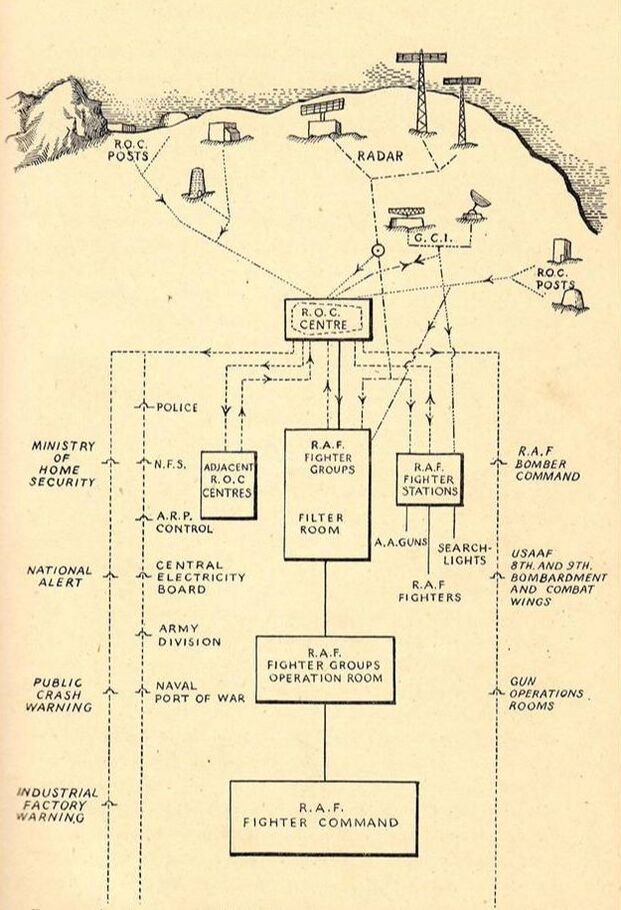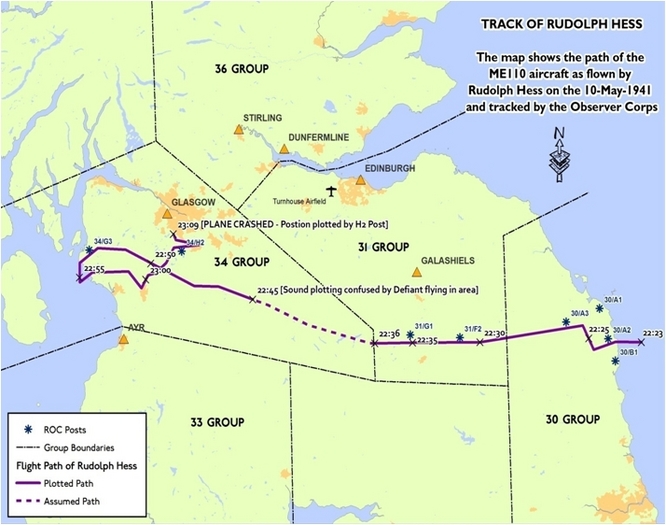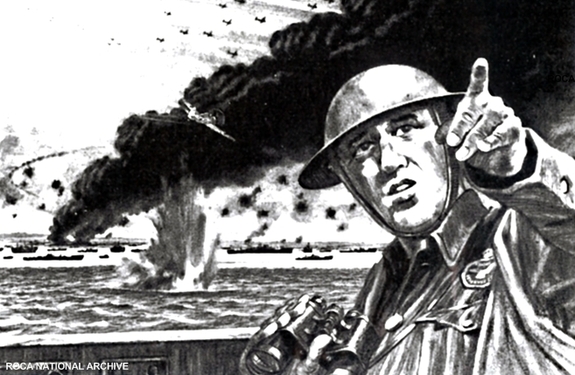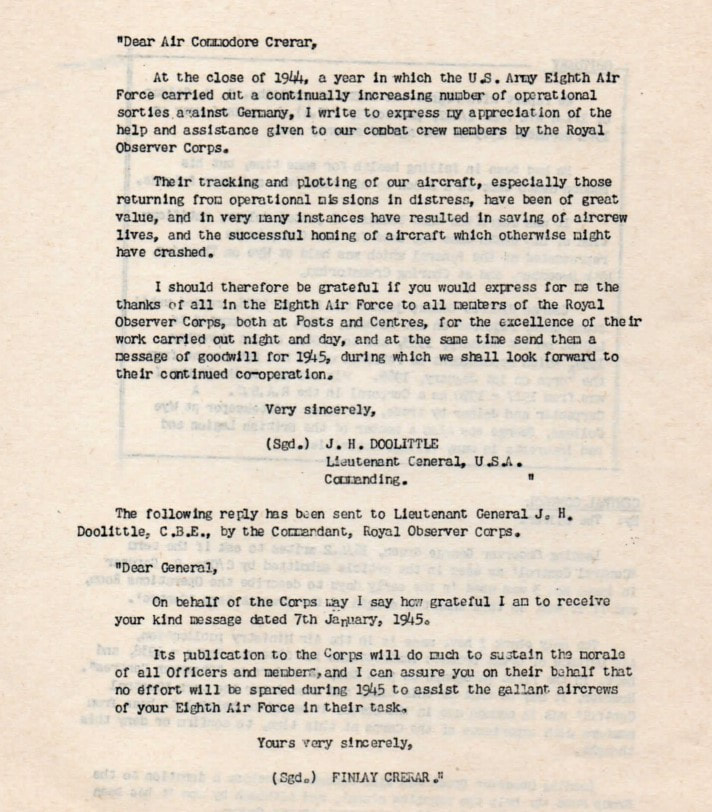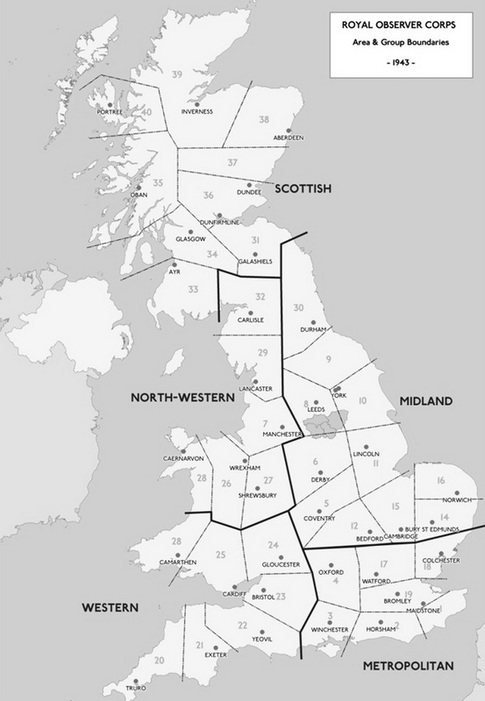1940's: THE OBSERVER CORPS AT WAR
Mobilisation
On 24 August 1939 Chief Constables issued mobilisation notices to all members of the Observer Corps. At this time the administration, recruitment and payment for voluntary members of the Corps was transferred from the Police Force directly to the Air Ministry. As a result the observers:-
On 24 August 1939 Chief Constables issued mobilisation notices to all members of the Observer Corps. At this time the administration, recruitment and payment for voluntary members of the Corps was transferred from the Police Force directly to the Air Ministry. As a result the observers:-
- Relinquished their Special Constable status which formed the initial basis of being a member of the Corps since initial setup.
- Became entitled to a remuneration of 1/3d. per hour, with a maximum of £3 a week and increased to £3 5/- by the award of a 5/- a week War Bonus from 1st July 1940.
- Were given the opportunity for applying for employment on a full time basis (48-hour week) or accepting part time employment.
War was eventually declared on 3 September 1939, with observer posts and centres being manned continuously until the end of the war on the 12th May 1945, four days after VE Day on 8th May 1945.
The first months of World War II were known as the Phoney War where there was little significant enemy aircraft activity over Britain however by the end of May 1940, The Battle of Dunkirk started when Allied troops were cut off by the German army in north-east France. This resulted in the evacuation of British troops in “Operation Dynamo” which ended on the 4th June. During this time the RAF lost 944 aircraft, half of these being fighters. Observer Corps posts in Kent and around the Thames estuary were able to play some part by observing and plotting aircraft while they were over England. It was however an extremely useful period for training and practice which proved to be extremely valuable within a few months.
“Battle of Britain” & Radar
After the invasion of France, the German aim was air superiority over Britainto be achieved by destroying RAF fighters in the air and on the ground, and by bombing aircraft factories. Winning the “Battle of Britain”, as it was soon called, was Germany's prerequisite in preparation for the invasion of Britain known as ‘Operation Sealion’. Radar [1], which used electromagnetic waves to identify the range, altitude, direction, or speed of both moving and fixed objects, had started to gain greater use during WW2, having been experimentally tested during 1935 by inventor Robert Watson-Watt. The British Chain Home radar system was developed and operational by 1940 and formed a ring of coastal radar stations comprising two types of radar:-
- Chain Home stations, or AMES Type 1 (Air Ministry Experimental Station), provided long-range detection.
- Chain Home Low stations, or AMES Type 2, were shorter-ranged but could detect aircraft flying at lower levels
The radar stations [2] were able to provide warning of enemy aircraft approaching the British coast, but once they had crossed the coastline the Observer Corps provided the only means of tracking them through the network of strategically placed observation posts.
During the period from July to October 1940 the Corps was fully stretched 24 hours a day plotting aircraft and passing this essential information to RAF groups and sectors. The Battle of Britain saw the start of the Blitz, the shift of German bombing from airfields to cities; the Observer Corps provided the information which enabled air raid warnings to be issued. The Blitz itself continued until early in the summer of 1941 and bombing on a reduced scale continued until March 1945.
During the period from July to October 1940 the Corps was fully stretched 24 hours a day plotting aircraft and passing this essential information to RAF groups and sectors. The Battle of Britain saw the start of the Blitz, the shift of German bombing from airfields to cities; the Observer Corps provided the information which enabled air raid warnings to be issued. The Blitz itself continued until early in the summer of 1941 and bombing on a reduced scale continued until March 1945.
| flying_control_and_the_royal_observer_corps.pdf | |
| File Size: | 61 kb |
| File Type: | |
Document written by Wing-Commander Thomson describing the invaluable work undertaken by the Royal Observer Corps in warning the country of the approach of enemy aircraft,
The Capture of Rudolph Hess
Rudolf Walter Richard Hess was a prominent Nazi politician and official acting as Adolf Hitler's Deputy in the Nazi Party during the 1930s and early 1940s. On the eve of war with the Soviet Union, he flew solo to Scotland in a believed attempt to negotiate peace with the United Kingdom, but instead was arrested and held in captivity for the rest of the war. Hess was tried at Nuremberg and sentenced to life in prison at Spandau Prison, Berlin, where he died in 1987.
On the night of May 10th 1941, Hitler's deputy, Rudolf Hess, took off from Augsburg, Germany in a Messerschmitt ME (Bf) 110. Adolf Hitler issued orders to have him stopped but squadron leaders were told to only scramble one or two fighters. At 22:10 hours, the lone ME110 approached the coast of Northumberland at an approximate height of 2,000ft. jettisoning its underwing fuel tanks close to the Holy Island, Radar began to track the aircraft as it passed over land. Immediately the aircraft was reported with a sound bearing and angle by A.2 post at Embelton nr Durham, whilst A.3 post at Chatton visually identified the aircraft as a ME110. The aircraft continued to lose height as it continued from east to west across the UK and being tracked at each stage by respective observer posts within Groups 30, 31 and 34.
After a flight of almost 1000 miles, at around 23:00 hours, Hess parachuted out over Eaglesham nr Glasgow. Post H.2 belonging to 34 Group reported “one man has just baled out and looks like landing safely” then “plane has come down out of control and crashed in flames” and logging exact grid references and the time as 23:09. Hess was found with a broken ankle by ploughman David McLean at Floors Farm. He surrendered to the ploughman who was armed with a pitchfork and told him in English, "I have an important message for the Duke of Hamilton". Hess was then offered tea at McClean's cottage before being taken into custody by the local Home Guard. The motive for this seemingly bizarre event still serves to baffle military and political experts to this day.
'Royal' Recognition
After the successes of 1940 and early 1941 and especially in respect to the work undertaken as the 'eyes and the ears' of the RAF during the 'Battle of Britain', on the 9th April 1941, His late Majesty King George VI the “Observer Corps” was provided with royal recognition and the retitle to the “Royal Observer Corps”.
After the successes of 1940 and early 1941 and especially in respect to the work undertaken as the 'eyes and the ears' of the RAF during the 'Battle of Britain', on the 9th April 1941, His late Majesty King George VI the “Observer Corps” was provided with royal recognition and the retitle to the “Royal Observer Corps”.
“In the history of the Royal Observer Corps, the vital service rendered by its members in the Battle of Britain will be outstanding ... No less distinguished has been its part since - in aiding the offensive operations of the Royal Air Force, in adapting itself to new enemy tactics on our coasts, in its brilliant seaborne enture during the invasion of Normandy, and in its preparations for and success in meeting the Flying Bomb attacks, and let us not forget its work in helping aircraft in distress.”
End of war message from the Secretary of State for War.
In his message to the Royal Observer Corps in May 1945. Air Marshal Sir Roderic M Hill KCB MC AFC, Air Officer Commanding-in-Chief Fighter Command, thanked the Corps in these terms;
“For nearly six years now, the Royal Observer Corps has maintained a continuous lookout on the skies over Britain. This vigil, in magnitude and time, far exceeds any hitherto recorded ... No Matter what surprise or what new tactics the enemy has sprung, the Royal Observer Corps has invariably risen to the occasion. Your triumph is the greater because your task has called for the sterner virtues of endurance, self-sacrifice, vigilance and patience of no ordinary kind. Among praiseworthy aspects of your work, I must allude specially to your tracking of friendly aircraft. Outsiders, perhaps, know little of its merits; but the Royal Air Force knows and is grateful. A very large number of aircrews of all commands owe their lives to your care.”
Although the organisation was to continue as a civilian organisation it was to be administered by the Royal Air Force, and for the first time women members were recruited. Members of both sexes were employed in two forms: Class A who was required to work for 56 hours a week, and Class B members who undertook up to 24 hours duty per week. For the rest of the war the ROC continued to provide an essential part of Britain's air defences.
|
|
British Pathe film produced in 1941 showing the role of the Observer Corps and its receiving of the "Royal" recognition due to success during the "Battle of Britain" ... The Observer Corps were now the Royal Observer Corps. |
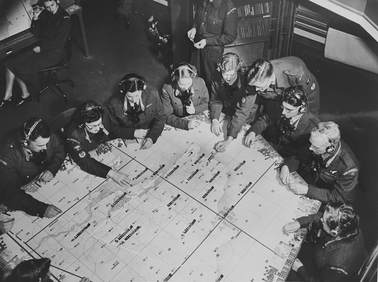 No.1 Group Beckenham ROC - Main Plotting Table
No.1 Group Beckenham ROC - Main Plotting Table
Women in the Corps
1941 saw the introduction of women into the Royal Observer Corps and with the introduction, saw slight changes in the Corps operations. Many knew next to nothing about the organisation that they were joining and so saw it with fresh eyes; their impressions were vivid, their viewpoint different.
The Corps’ work was until the big recruitment drive in November 1943; little known to the general public. Local papers and especially the ‘Picture Post’ however aimed to set about dispelling the secrecy as the need to recruit more women became increasingly urgent. In these early days of women in the Corps, between September 1941 and the big recruitment drive in November 1943, many women who joined only knew about the corps from a serving member, or had a personal reason for interest in the kind of work done by the ROC.
At first the Royal Observer Corps was rather protective towards its women members, for example they were not initially allowed to work the night shift. But it was rapidly realised that the youthful, fragile appearance of the ladies belied their tough resilience. So the two main categories of Observers was not male and female, but ...
- A Class – Full Time and working at least 48 hours a week and usually rotating shifts of 8 hours.
- B Class – Part Time and were generally those in reserved occupations or in the case of women, those with domestic commitments; who devoted up to 24 hours per week of their ‘leisure’ to Corps duties and usually working 4 hour shifts except at night when it usually was an 8 hour shift.
As part of the ‘team’; restrictions did still exist as to women’s activities especially at posts where many groups avoided mixed crews; most did not allow women to work the night shift, and none permitted a women to share the night duty with a man.
Despite performing the same duties as men, women were paid less. Most agree they earned 10d (old pence) an hour whilst the men were paid 1/3 (one and threepence) or more. By the end of the war, women’s pay had increased to 1/- (one shilling). The monetary inequality does not seem to have worried the women unduly, probably because it was accepted as the norm in those days.
Despite performing the same duties as men, women were paid less. Most agree they earned 10d (old pence) an hour whilst the men were paid 1/3 (one and threepence) or more. By the end of the war, women’s pay had increased to 1/- (one shilling). The monetary inequality does not seem to have worried the women unduly, probably because it was accepted as the norm in those days.
“Seaborne”
On the 6th June 1944, the largest amphibious assault in history was launched against the Normandycoast – its ultimate goal was the establishment of an allied foothold in Nazi-occupied France. During preparations for this invasion; (commonly known as D-Day and code named “Operation Overlord”), the Air Ministry issued a confidential order A63/1944, which consisted of the proposals for the Royal Observer Corps to participate in the forthcoming Operations. The order outlined an urgent need for a substantial number of “expert” ROC Observers to be employed on recognition duties in defensively-equipped merchant ships. Their initial role was to advise as to the identity of aircraft at sea. This role was deemed to be only advisory, and responsibility for accepting or rejecting the advice and taking any necessary action rested with the ship’s captain.
Over 1,000 candidates applied to join as Seaborne Observers of which approximately 800 were selected to perform the seaborne duties. Under the leadership of Group Commandant C.G. Cooke, these “Seaborne” Observers were trained at the Royal Bath Hotel in Bournemouth before temporarily joining the Royal Navy with the rank of Petty Officer (Aircraft Identifier). They continued to wear their ROC uniforms, but wore 'Seaborne' shoulder flashes and a Royal Navy brassard with the letters ‘RN’.
During the D-Day Landings two Seaborne observers were allocated to each warship of the U.S. Navy and the defensively equipped merchant ships and were duly given control of each ship’s anti-aircraft battery, thereby reducing any risk of friendly fire incidents, which had previously been at a relatively high level. In total over the period of the operation, only two observers lost their lives; 22 survived their ships being sunk and a number being injured during the landings. The Seaborne operation was seen as an unqualified success and was recognised by His Majesty King George VI, by the approval of the use of “Seaborne” shoulder titles as a permanent feature of the observer uniform. After the invasion and just before his death Air Chief Marshall Trafford Leigh Mallory wrote the following to be circulated to all ROC personnel.
On the 6th June 1944, the largest amphibious assault in history was launched against the Normandycoast – its ultimate goal was the establishment of an allied foothold in Nazi-occupied France. During preparations for this invasion; (commonly known as D-Day and code named “Operation Overlord”), the Air Ministry issued a confidential order A63/1944, which consisted of the proposals for the Royal Observer Corps to participate in the forthcoming Operations. The order outlined an urgent need for a substantial number of “expert” ROC Observers to be employed on recognition duties in defensively-equipped merchant ships. Their initial role was to advise as to the identity of aircraft at sea. This role was deemed to be only advisory, and responsibility for accepting or rejecting the advice and taking any necessary action rested with the ship’s captain.
Over 1,000 candidates applied to join as Seaborne Observers of which approximately 800 were selected to perform the seaborne duties. Under the leadership of Group Commandant C.G. Cooke, these “Seaborne” Observers were trained at the Royal Bath Hotel in Bournemouth before temporarily joining the Royal Navy with the rank of Petty Officer (Aircraft Identifier). They continued to wear their ROC uniforms, but wore 'Seaborne' shoulder flashes and a Royal Navy brassard with the letters ‘RN’.
During the D-Day Landings two Seaborne observers were allocated to each warship of the U.S. Navy and the defensively equipped merchant ships and were duly given control of each ship’s anti-aircraft battery, thereby reducing any risk of friendly fire incidents, which had previously been at a relatively high level. In total over the period of the operation, only two observers lost their lives; 22 survived their ships being sunk and a number being injured during the landings. The Seaborne operation was seen as an unqualified success and was recognised by His Majesty King George VI, by the approval of the use of “Seaborne” shoulder titles as a permanent feature of the observer uniform. After the invasion and just before his death Air Chief Marshall Trafford Leigh Mallory wrote the following to be circulated to all ROC personnel.
“I have reports from both pilots and naval officers regarding the Seaborne volunteers who have more than fulfilled their duties and have undoubtedly saved many of our aircraft from being engaged by our ships guns …”
“… I should be grateful if you would please convey to all ranks of the Royal Observer Corps, and in particular to the Seaborne Observers themselves, how grateful I and all pilots in the Allied Expeditionary Air Force are, for their assistance, which has contributed in no small measure to the safety of our own aircraft, and also to the efficient protection of the ships at sea …”
“ … The work of the Royal Observer Corps is quite unjustly overlooked, and on this occasion be as advertised as possible, and all units of the Air Defence of Great Britain are therefore to be informed of the success of this latest venture of the Royal Observer Corps”.
“… I should be grateful if you would please convey to all ranks of the Royal Observer Corps, and in particular to the Seaborne Observers themselves, how grateful I and all pilots in the Allied Expeditionary Air Force are, for their assistance, which has contributed in no small measure to the safety of our own aircraft, and also to the efficient protection of the ships at sea …”
“ … The work of the Royal Observer Corps is quite unjustly overlooked, and on this occasion be as advertised as possible, and all units of the Air Defence of Great Britain are therefore to be informed of the success of this latest venture of the Royal Observer Corps”.
|
This document provides an account of the activities of the volunteers from 8 Group (Leeds - WW2 structure - Details Below) during their period of service with the Royal Navy as Aircraft Identifiers between May and July 1944.
| ||||||
Satellite Posts
From 1940, and in particular from 1942, to combat the threat of the low level intruder and to improve low level coverage in the ROC reporting chain, it was decided to establish approximately 150 ‘satellite’ posts in a belt that stretched 30 miles wide along the south coast of the UK and on the east coast as far north as Dundee, as well as on the coast of Lancashire and Cheshire.
The posts were operation by four groups consisting of the ROC, RAF, Army (Anti-aircraft) and Coastguard. The RAF and Army generally manned their own satellite posts whilst the ROC personnel manned ROC satellites and also some of those set up at coastguard stations.
Further information relating top Satellite Posts may be found by clicking the button below.
From 1940, and in particular from 1942, to combat the threat of the low level intruder and to improve low level coverage in the ROC reporting chain, it was decided to establish approximately 150 ‘satellite’ posts in a belt that stretched 30 miles wide along the south coast of the UK and on the east coast as far north as Dundee, as well as on the coast of Lancashire and Cheshire.
The posts were operation by four groups consisting of the ROC, RAF, Army (Anti-aircraft) and Coastguard. The RAF and Army generally manned their own satellite posts whilst the ROC personnel manned ROC satellites and also some of those set up at coastguard stations.
Further information relating top Satellite Posts may be found by clicking the button below.
The Death of Observer Kelway
During the final stages of the War, the German Luftwaffe under the codename Operation (Unterhehmen) Gisella, made a last minute attempt at turning around their losing situation. In the early hours of 4th March 1945, approximately 150-200 Junkers JU88 night-fighters of the Luftwaffe Nachtjagdeschwader Gruppen (Night Fighter destroyer Group) were deployed to intercept over 500 allied bombers returning to their bases at their most vulnerable point, just before landing.
Halifax squadrons returning to Yorkshire from operations against the Kamen Oil refinery and special duty squadrons landing in Norfolk and Lancasters returning to Lincolnshire from Ladbergan - all became the prey of the prowling Luftwaffe night fighters in the moonlit eastern counties. The following lists the aircraft casualties during that night over Lincolnshire:-
During the final stages of the War, the German Luftwaffe under the codename Operation (Unterhehmen) Gisella, made a last minute attempt at turning around their losing situation. In the early hours of 4th March 1945, approximately 150-200 Junkers JU88 night-fighters of the Luftwaffe Nachtjagdeschwader Gruppen (Night Fighter destroyer Group) were deployed to intercept over 500 allied bombers returning to their bases at their most vulnerable point, just before landing.
Halifax squadrons returning to Yorkshire from operations against the Kamen Oil refinery and special duty squadrons landing in Norfolk and Lancasters returning to Lincolnshire from Ladbergan - all became the prey of the prowling Luftwaffe night fighters in the moonlit eastern counties. The following lists the aircraft casualties during that night over Lincolnshire:-
|
00.29 hours 00.40 hours 00.57 hours 01.00 hours 01.02 hours 01.05 hours 01.05 hours 01.05 hours 01.10 hours 01.15 hours 01.18 hours 01.36 hours |
Lancaster of 12 Sqdn (Wickenby) shot down at Ulceby Cross near Alford - No survivors. Halifax of 466 RAAF Sqdn shot at over Waddington near Lincoln - Crew bailed out with the aircraft continuing crewless toward the coast before crashing onto a cottage at Friskney near Skegness killing three people. Lancaster of 1654 HCU (Wigsley) shot down at Church Warsop near Mansfield - Crew managed to bale safely except for the mid-upper gunner who was killed. Lancaster of 460 RAAF Sqdn (Binbrook) shot down on farmland at Barfield House, Langworth - Crew bailed out under repeat attack by the german JU88 aircraft. Lancaster of 1654 HCU (Wigsley) attacked over their home airfield of Wigsley - the rear gunner baled out, but the pilot managed to land the aircraft at High Ercall. Halifax attacked to the east of Fulbeck, in the direction of Cranwell evenually being shot down near Anwick Grange killing both aircrew. Lancaster of 1654 HCU (Wigsley) shot down, and dived into the ground at Stapleford Wood between Fulbeck and Newark - all the crew were killed. Lancaster of 1662 HCU at Blyton near Gainsborough was attacked in the Doncaster area - Pilot managed to land safely. Lancaster of 12 Sqdn (Wickenby), was shot down and fell at East Stockwith near Blyton - All the crew were killed. Lancaster of 44 Sqdn (Spilsby) shot down over Brocklesby Park near Brigg - All crew killed. [A memorial plaque dedicated to this crew has been placed on a tree near where they perished]. Lancaster of 189 Squadron shot down and crashed into the East Rudham Railway Station - All crew were killed. Halifax of 76 Sqdn. shot down and crashed at Cadney near Brigg - All crew survived. |
Observer Jack Perotti Kelway, was a member of L.1 Post, No 11 Group, Royal Observer Corps at Lincoln. Not following his usual custom of sleeping at his post prior to duty, at approximately 01.00 hours in the early morning of 4th March, saw him motoring to duty along the Welton to Hackthorn road, some 2 miles east of Scampton airfield. At the same time a German Junkers JU88 flown by Feldwebel Heirich Conze and crew who had minutes earlier downed and strafed a Lancaster of 460 RAAF Sqdn, Binbrook at Langworth (highlighted above) were looking for ground targets to attack.
Although Observer Kelway's car lights were hooded according to regulations, there must have been just enough light to be seen by Conze. The Junkers Ju88 came streaking in at ground level aiming straight at Kelway's car when it struck telegraph wires and then the ground before hitting the car and flinging it across two fields. Kelway was killed instantly, as were the four-person crew in the Ju88. Observer Kelway was buried in Newport Cemetery, Lincoln, on 7th March 1945 with a large number of his fellow observers attending. He was the only member of the ROC to be killed on duty. The German crew are buried in Scampton Churchyard.
Further information relating to Operation Gisella and the Death of Observer Kelway may be found on the website of the 49th Squadron Association -
http://www.bomberhistory.co.uk/49squadron/.
"Granite"
During the war, many aircraft were lost each year through flying into areas of high ground. Therefore a need arose to provide effective warning to aircraft. The Royal Air Force was eventually in a position with help from the Royal Observer Corps to alleviate this problem by developing a scheme known as “Granite”.
The principle of “Granite” was to make use of red ground flares in the path of an aircraft that was deemed to be flying towards high ground in order to allow the aircraft to take evasive action. Areas such as the Derbyshire Dales, Pennines, Lake District, Scotland and Wales were initially included in the “Granite” scheme with the scheme being later expanded to cover the whole of England, Scotland and Wales. By the end of the war, 340 ROC Observer Posts were part of the “Granite” system”. The system ended on the 12 May 1945 when the ROC organisation was stood down.
During the war, many aircraft were lost each year through flying into areas of high ground. Therefore a need arose to provide effective warning to aircraft. The Royal Air Force was eventually in a position with help from the Royal Observer Corps to alleviate this problem by developing a scheme known as “Granite”.
The principle of “Granite” was to make use of red ground flares in the path of an aircraft that was deemed to be flying towards high ground in order to allow the aircraft to take evasive action. Areas such as the Derbyshire Dales, Pennines, Lake District, Scotland and Wales were initially included in the “Granite” scheme with the scheme being later expanded to cover the whole of England, Scotland and Wales. By the end of the war, 340 ROC Observer Posts were part of the “Granite” system”. The system ended on the 12 May 1945 when the ROC organisation was stood down.
| Operation Granite | |
| File Size: | 7512 kb |
| File Type: | |
ROC Recognition & Support
During the period leading up to the end of WW2, the ROC received many messages of gratitude and thanks for the work that they had undertaken. The ultimate gratitude had already been placed on the Observer Corps in 1941, by the royal recognition of King George VI and subsequent retitle to the “Royal Observer Corps”.
Later many others provided their gratitude to the Corps for the work undertaken during the Battle of Britain, 'Granite' operations of posts, the Seaborne Observers and within Satellite Posts to name a few.
During the period leading up to the end of WW2, the ROC received many messages of gratitude and thanks for the work that they had undertaken. The ultimate gratitude had already been placed on the Observer Corps in 1941, by the royal recognition of King George VI and subsequent retitle to the “Royal Observer Corps”.
Later many others provided their gratitude to the Corps for the work undertaken during the Battle of Britain, 'Granite' operations of posts, the Seaborne Observers and within Satellite Posts to name a few.
Letter sent from Lieutenant General J.H. (Jimmy) Doolittle of the U.S. Eighth Air Force (Europe) to Air Commodore Finlay Crerar providing thanks and appreciation to the ROC for the excellence of their work in night and day aircraft spotting.
Stand-Down
On 12 May 1945, when it was certain that all Luftwaffe aircraft were grounded, the ROC temporarily stood down. In recognition of the contribution made by ROC personnel in the allied victory, the Air Ministry held a massed RAF rally and air display at RAF North Weald, in Essex, from Saturday 23 to Monday 25 of June 1945. Over 2,000 ROC personnel were invited to attend, with at least two observers from each ROC facility representing their respective post or centre. As part of the event, the new Ensign of the ROC, was dedicated at a special service.
On the day of the dedication of the ensign, (Sunday 24th), the approximately 2,000 observers present undertook the first ever uniformed ROC march-past to the accompaniment of the RAF Band, with the Under-Secretary of State for Air, Lord Beatty, taking the salute. The parade then formed into a huge square and the ROC Ensign was presented by Lord Beatty. The Ensign was borne from the drumhead by Observer Lieutenant Pollock, VC. During the parade, Observer Lieutenant Pollock carried the Ensign, flanked by two senior NCO’s, at the head of the massed contingent of observers. Approximately 18-months later from the stand-down the ROC would be re-activated to meet post-war threats.
Corps’ Structure during WW2 to Stand-Down
The headquarters of each group was operated from a Centre and it controlled about 30 to 40 Posts. Each of these would be some 8 km to 13 km (5 to 8 miles) from its neighbour. By the end of the war in 1945 there were some 40 centres covering England,Wales and Scotland, controlling in total approximately 1,560 observer posts. The ROC did not operate in Northern Ireland until 1954.
On 12 May 1945, when it was certain that all Luftwaffe aircraft were grounded, the ROC temporarily stood down. In recognition of the contribution made by ROC personnel in the allied victory, the Air Ministry held a massed RAF rally and air display at RAF North Weald, in Essex, from Saturday 23 to Monday 25 of June 1945. Over 2,000 ROC personnel were invited to attend, with at least two observers from each ROC facility representing their respective post or centre. As part of the event, the new Ensign of the ROC, was dedicated at a special service.
On the day of the dedication of the ensign, (Sunday 24th), the approximately 2,000 observers present undertook the first ever uniformed ROC march-past to the accompaniment of the RAF Band, with the Under-Secretary of State for Air, Lord Beatty, taking the salute. The parade then formed into a huge square and the ROC Ensign was presented by Lord Beatty. The Ensign was borne from the drumhead by Observer Lieutenant Pollock, VC. During the parade, Observer Lieutenant Pollock carried the Ensign, flanked by two senior NCO’s, at the head of the massed contingent of observers. Approximately 18-months later from the stand-down the ROC would be re-activated to meet post-war threats.
Corps’ Structure during WW2 to Stand-Down
The headquarters of each group was operated from a Centre and it controlled about 30 to 40 Posts. Each of these would be some 8 km to 13 km (5 to 8 miles) from its neighbour. By the end of the war in 1945 there were some 40 centres covering England,Wales and Scotland, controlling in total approximately 1,560 observer posts. The ROC did not operate in Northern Ireland until 1954.
Area & Group Boundaries during WW2
[1] Radar – Radio Detection And Ranging
[2] Germany had also developed radar and which was deemed to be more advanced than that in use in Britain. Their system however was developed for use at sea and was deemed to be less integrated and therefore was not so much of a problem to the RAF
[2] Germany had also developed radar and which was deemed to be more advanced than that in use in Britain. Their system however was developed for use at sea and was deemed to be less integrated and therefore was not so much of a problem to the RAF
Image Source: ROCA National Archive via ROC Journal
Map Source: South Yorkshire ROC Collection
Information Source relating to the death of Observer Kelway: 49th Squadron Association & D Wood - Attack Warning Red
